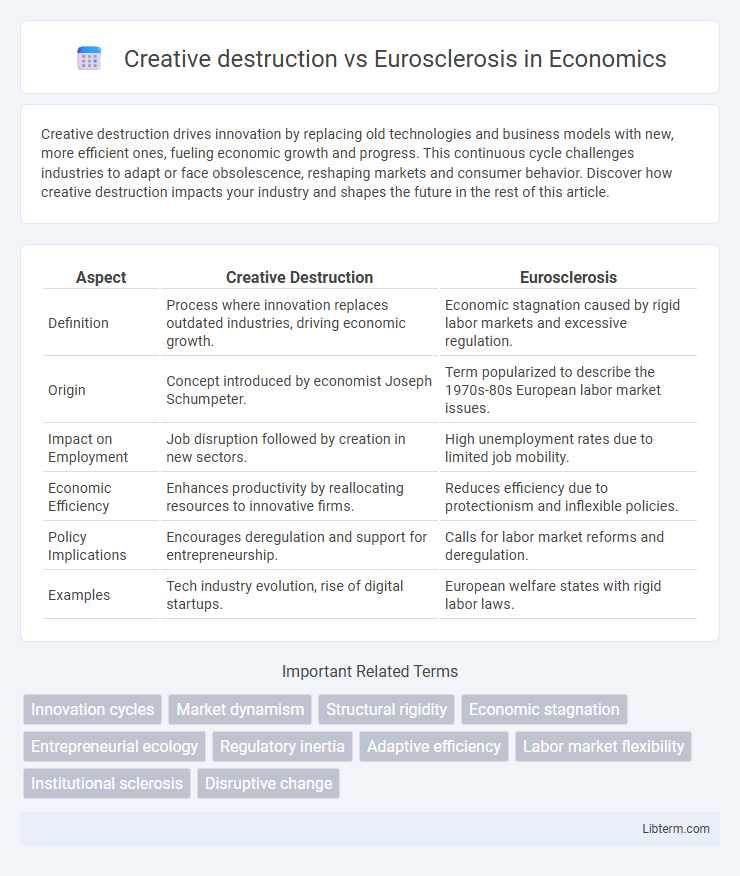Creative destruction drives innovation by replacing old technologies and business models with new, more efficient ones, fueling economic growth and progress. This continuous cycle challenges industries to adapt or face obsolescence, reshaping markets and consumer behavior. Discover how creative destruction impacts your industry and shapes the future in the rest of this article.
Table of Comparison
| Aspect | Creative Destruction | Eurosclerosis |
|---|---|---|
| Definition | Process where innovation replaces outdated industries, driving economic growth. | Economic stagnation caused by rigid labor markets and excessive regulation. |
| Origin | Concept introduced by economist Joseph Schumpeter. | Term popularized to describe the 1970s-80s European labor market issues. |
| Impact on Employment | Job disruption followed by creation in new sectors. | High unemployment rates due to limited job mobility. |
| Economic Efficiency | Enhances productivity by reallocating resources to innovative firms. | Reduces efficiency due to protectionism and inflexible policies. |
| Policy Implications | Encourages deregulation and support for entrepreneurship. | Calls for labor market reforms and deregulation. |
| Examples | Tech industry evolution, rise of digital startups. | European welfare states with rigid labor laws. |
Understanding Creative Destruction: Definition and Origins
Creative destruction, a concept popularized by economist Joseph Schumpeter, refers to the process where innovation continuously disrupts and replaces outdated industries, driving economic growth and technological progress. Originating in Schumpeter's 1942 work "Capitalism, Socialism and Democracy," this dynamic mechanism emphasizes entrepreneurial innovation as the engine of capitalist evolution. This contrasts sharply with Eurosclerosis, which describes economic stagnation and labor market rigidity in Europe during the 1970s and 1980s, highlighting the challenge of fostering innovation under strict regulatory environments.
The Concept of Eurosclerosis: A Historical Perspective
Eurosclerosis refers to the prolonged stagnation and high unemployment experienced by European economies, particularly during the 1970s and 1980s, characterized by rigid labor markets and excessive regulation. This period contrasted sharply with the theory of creative destruction, which emphasizes continuous innovation and economic renewal through the dismantling of outdated industries. Historical evidence shows that eurosclerosis hindered economic dynamism and productivity growth, delaying structural reforms needed for adaptability in a rapidly changing global landscape.
Key Differences Between Creative Destruction and Eurosclerosis
Creative destruction drives economic growth by continuously replacing outdated industries with innovative technologies and business models, fostering dynamic market adjustments and enhanced productivity. Eurosclerosis refers to a prolonged period of economic stagnation characterized by rigid labor markets, excessive regulation, and resistance to structural reforms, resulting in slow job creation and reduced competitiveness. The key difference lies in creative destruction's emphasis on innovation-led economic renewal, whereas eurosclerosis denotes a scenario of institutional and regulatory inertia that hampers economic flexibility and growth.
Innovation and Economic Growth: The Role of Creative Destruction
Creative destruction drives innovation by continuously replacing outdated technologies with new, more efficient ones, fueling sustained economic growth. In contrast, eurosclerosis describes stagnation in European economies due to rigid regulations and limited entrepreneurial activity, hindering innovation. Emphasizing creative destruction highlights the importance of flexible markets and innovation-friendly policies for dynamic economic development.
Structural Rigidities: How Eurosclerosis Impacts Economies
Eurosclerosis refers to prolonged economic stagnation in Europe caused by structural rigidities such as inflexible labor markets, excessive regulation, and strong union protections that hinder innovation and adaptation. These structural impediments prevent creative destruction--the continuous process of replacing outdated industries with new, more efficient ones--resulting in slower economic growth and reduced competitiveness. Overcoming Eurosclerosis requires reforms that increase labor market flexibility and reduce regulatory burdens to enable dynamic economic restructuring and innovation.
Case Studies: Creative Destruction in Action
Creative destruction drives economic growth by continuously replacing outdated industries with innovative technologies, as demonstrated by Silicon Valley's rise through startups disrupting traditional sectors like telecommunications and retail. In contrast, Eurosclerosis illustrates how rigid labor markets and regulatory frameworks in several European countries during the 1970s and 1980s stifled innovation and prolonged economic stagnation. Case studies such as Germany's Mittelstand firms show how adaptive innovation amidst structural reforms can mitigate eurosclerotic effects and sustain competitive advantage.
Examples of Eurosclerosis in European Economies
Eurosclerosis is characterized by prolonged economic stagnation, rigid labor markets, and excessive regulation that impede growth in several European economies, notably in France and Italy during the 1970s and 1980s. High unemployment rates and inflexible employment protection laws contributed to slow job creation and persistent economic inefficiencies in these countries. This contrasts with the process of creative destruction, where outdated industries give way to innovative sectors, fueling dynamic economic transformation.
Policy Implications: Fostering Dynamism vs. Avoiding Stagnation
Policies promoting creative destruction emphasize deregulation, innovation incentives, and flexible labor markets to foster economic dynamism and long-term growth. In contrast, combating eurosclerosis requires targeted structural reforms, investment in education, and measures to reduce bureaucratic rigidity to prevent prolonged stagnation and unemployment. Balancing these approaches is crucial for policymakers to stimulate productivity while ensuring social stability and inclusive economic progress.
Balancing Social Welfare and Economic Flexibility
Creative destruction drives economic growth by fostering innovation and reallocating resources to more productive ventures, boosting competitiveness and efficiency. Eurosclerosis, characterized by excessive regulation and rigid labor markets in some European economies, hampers flexibility and stifles entrepreneurship, leading to slower job creation and economic stagnation. Balancing social welfare policies with economic flexibility requires designing adaptive labor laws and targeted social protections that support workers during transitions without undermining incentives for innovation and market dynamism.
The Future of Europe: Choosing Between Renewal and Stagnation
Creative destruction, driven by innovation and entrepreneurial activity, acts as a catalyst for economic renewal in Europe, fostering competitiveness and dynamic growth. Eurosclerosis, characterized by rigid labor markets and excessive regulation, contributes to stagnation by hindering flexibility and discouraging investment. The future of Europe hinges on embracing transformative policies that prioritize innovation and structural reforms to overcome stagnation and ensure sustainable development.
Creative destruction Infographic

 libterm.com
libterm.com